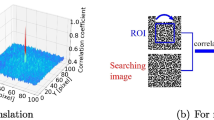Abstract
It is shown that the effect of the nonlinear characteristic curve of a film on a narrow-band moiré signal is to generate, for each narrow-band component of the moiré signal, an infinite number of narrow-band, high-order harmonics of the fundamental argument. According to this result, the elimination of the film nonlinearity can be achieved by means of band-pass filters. Two examples are given to show that the elimination predicted theoretically can be achieved in practice.
Similar content being viewed by others
Abbreviations
- A k :
-
coefficient in the expansion of the distorted intensity distribution
- C k :
-
coefficient in the Fourier expansion of the functione iz cos φ,C k =2,k≠0
- D :
-
photographic density
- f(I) :
-
characteristic curve of the film
- F(iξ) :
-
complex Fourier transform off(I)
- F(p) :
-
LaPlace transform
- i :
-
imaginary unit
- I(x) :
-
light intensity in the image plane at the point of coordinatex
- I o :
-
background-light intensity
- I 1 :
-
light-intensity amplitude of the first harmonic
- Ī(x) :
-
intensity distribution resulting from the film nonlinear behavior
- J k (z) :
-
Bessel function of the first kind of orderk and argumentz
- T :
-
symbolical nonlinear transformation of the input intensity
- z :
-
variable exponent of the functione iz cos φ, and argument of the Bessel functions that appear in the Fourier expansion of the above function
- γ:
-
slope of the rectilinear portion of the characteristic curve of a film
- ωo :
-
angular frequency of the unmodulated carrier
- ϕ:
-
argument of the cosine in the functione iz cos φ, and fundamental argument in the Fourier expansion of the above function
- φ c :
-
initial phase
- ϕ(x):
-
modulation function
References
Sciammarella, C. A., “Basic Optical Law in the Interpretation of Moiré Patterns Applied to the Analysis of Strains, Part I,”Experimental Mechanics,5,5 (1965).
Sciammarella, C. A., “Techniques of Fringe Interpolation in Moiré Patterns,” Proc. Second SESA International Congress on Experimental Mechanics (1966).
Sciammarella, C. A., and Sturgeon, D., “Digital Filtering Techniques Applied to the Interpolation of Moiré Data,” presented at the fall meeting of SESA in Pittsburgh, Pa. (1966).
Papoulis, A., “The Fourier Integral and Its Application,”McGraw Hill, New York (1962).
Watson, G. N., “Theory of Bessel Functions,”MacMillan, New York (1944).
Author information
Authors and Affiliations
Rights and permissions
About this article
Cite this article
Sciammarella, C.A., Doddington, C.W. Effect of photographic-film nonlinearities on the processing of moiré-fringe data. Experimental Mechanics 7, 398–402 (1967). https://doi.org/10.1007/BF02326312
Issue Date:
DOI: https://doi.org/10.1007/BF02326312




